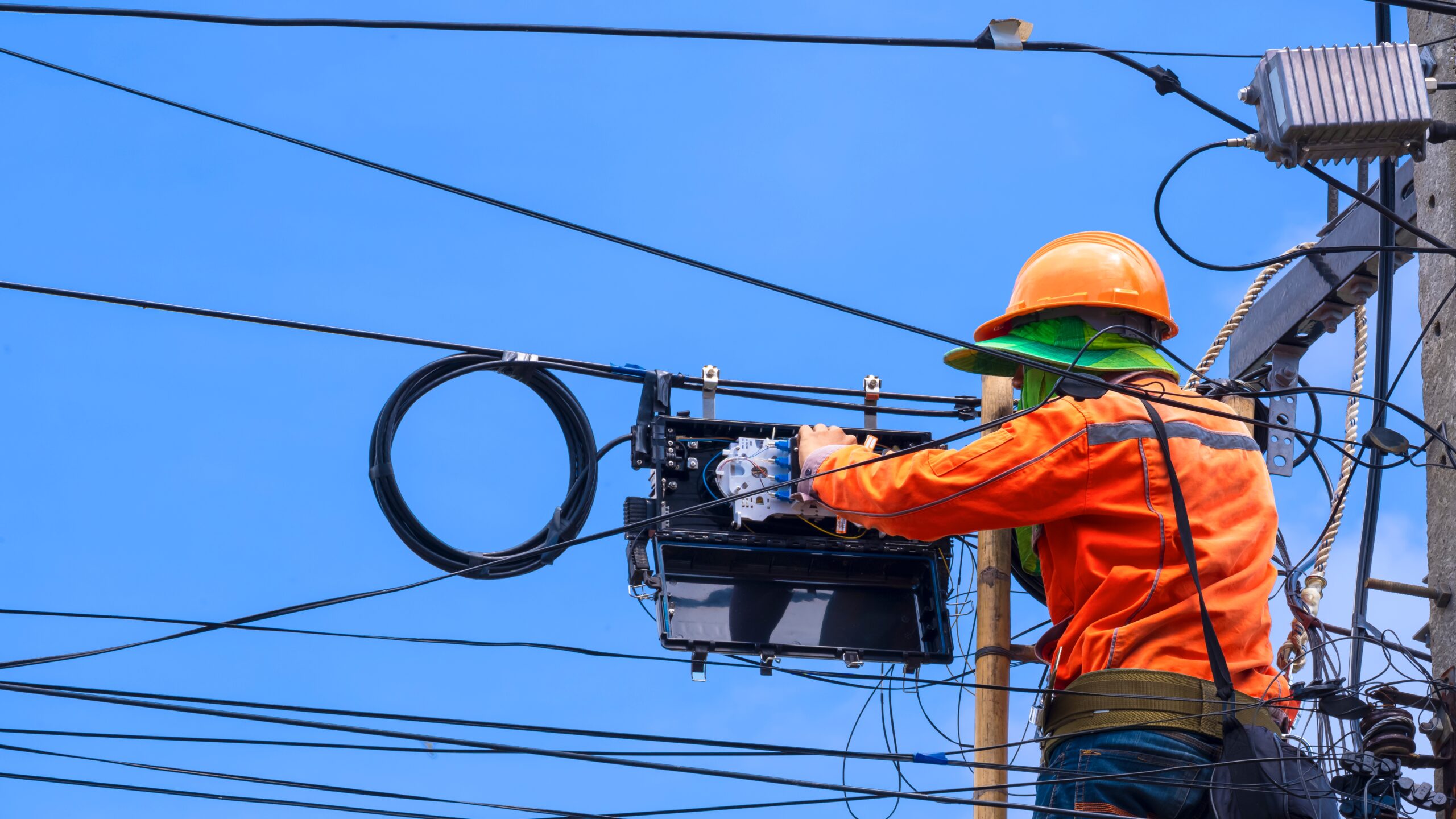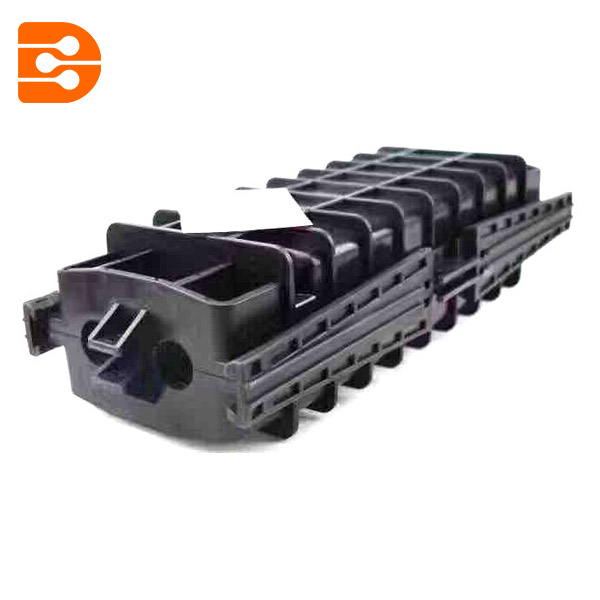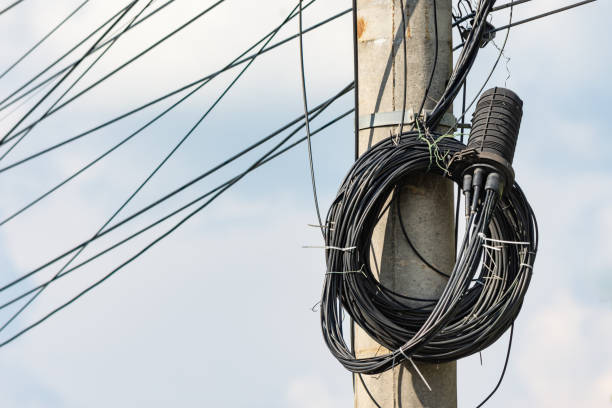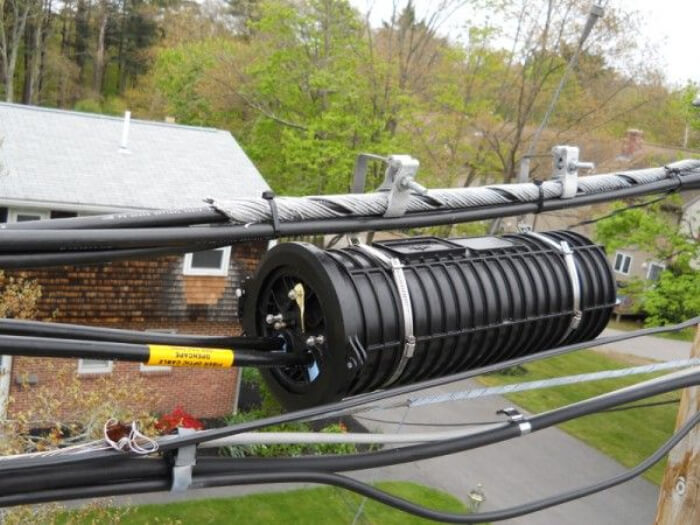Smart city lighting systems demand robust and efficient communication networks to support their advanced functionalities. Fiber optic technology plays a pivotal role in this transformation by enabling high-speed data transmission across interconnected lighting infrastructures. Fiber optic splice closures act as critical components in these networks, ensuring seamless connectivity and safeguarding spliced fibers from environmental and mechanical threats. Their innovative designs, such as vertical splice closures and horizontal splice closures, offer superior protection against moisture, dust, and vibrations caused by urban activities. By integrating mechanical fiber optic closures and dome fiber optic closures into urban frameworks, cities can enhance data reliability and reduce the risk of connection issues.
Key Takeaways
- Fiber optic splice closures keep fiber connections safe from harm. This helps ensure smooth data flow in smart city lights.
- These closures are built to handle bad weather and pressure. They work well in busy city areas.
- They can grow with the city’s needs. Cities can add more without replacing old closures, saving time and money.
- Using good splice closures lowers repair costs over time. It also makes smart lighting systems work better.
- Adding fiber optics to IoT tech saves energy and keeps cities safer.
Understanding Fiber Optic Splice Closures
Definition and Purpose
Fiber optic splice closures are essential components in modern communication networks. They serve as protective enclosures for spliced fiber optic cables, ensuring the integrity of connections in both underground and aerial installations. These closures shield the delicate spliced fibers from environmental factors such as moisture, dust, and temperature fluctuations. By maintaining a secure and stable environment, they enable uninterrupted data transmission, which is critical for smart city lighting systems.
The primary purpose of these closures is to provide a reliable and scalable solution for managing fiber optic connections. Their design accommodates various cable types and configurations, making them versatile for diverse urban applications. Whether used in high-traffic areas or remote locations, fiber optic splice closures ensure that the network remains robust and efficient.
Key Features and Technologies
Fiber optic splice closures incorporate advanced features and technologies to meet the demands of modern networks. These include:
- Weather Resistance: High-quality sealing mechanisms protect against rain, snow, and UV radiation, ensuring long-term functionality.
- Physical Stress Resistance: Dome-shaped closures minimize damage from external forces, preserving the integrity of spliced fibers.
- Aging and Degradation Resistance: Durable materials resist aging, enabling effective performance in diverse environments.
Additionally, vertical splice closures offer significant advantages for urban networks. They have a substantial fiber holding capacity, allowing them to manage numerous spliced fibers efficiently. Their design includes multiple splice trays, which provide organized storage and easy access for maintenance. Scalability is another key feature, enabling network expansion without compromising performance. This adaptability makes them ideal for growing smart city infrastructures.
Role in Fiber Optic Networks
Fiber optic splice closures play a pivotal role in the functionality and reliability of fiber optic networks. They act as junction points where multiple cables converge, facilitating seamless data transmission across the network. By protecting spliced fibers from environmental and mechanical stress, these closures ensure consistent performance even in challenging conditions.
The integration of fiber optic splice closures into smart city lighting systems enhances connectivity and data flow. Their ability to accommodate network expansions supports the increasing demand for interconnected devices and IoT applications. For example, cities can integrate these closures into their lighting systems to enable real-time monitoring and control, improving energy efficiency and public safety.
| Feature | Description |
|---|---|
| Weather Resistance | Excellent sealing capabilities protect against rain, snow, and UV radiation, ensuring functionality. |
| Physical Stress Resistance | Dome shape minimizes damage from external forces, maintaining spliced fibers’ integrity. |
| Aging and Degradation Resistance | Materials resist aging, ensuring effective function in diverse environments. |
By combining durability, scalability, and advanced technology, fiber optic splice closures form the backbone of reliable and efficient communication networks. Their role in supporting smart city initiatives highlights their importance in modern urban development.
Benefits of Fiber Optic Splice Closures in Smart City Lighting
Enhanced Connectivity and Data Transmission
Fiber optic splice closures significantly enhance connectivity and data transmission in smart city lighting systems. By securely housing spliced fiber optic cables, these closures maintain the integrity of high-speed data networks. This reliability ensures that smart lighting systems can operate efficiently, enabling real-time communication between interconnected devices. For instance, streetlights equipped with sensors can transmit data about traffic flow or environmental conditions without interruptions, improving urban management.
The advanced sealing mechanisms in these closures prevent external contaminants from interfering with the fiber connections. This protection ensures consistent data flow, even in challenging environments. As cities continue to adopt Internet of Things (IoT) technologies, the role of fiber optic splice closures becomes increasingly vital in supporting the seamless exchange of information.
Durability and Environmental Protection
Fiber optic splice closures are designed to withstand harsh environmental conditions, ensuring long-term durability. Rigorous testing validates their ability to endure mechanical stress and environmental challenges. These tests include:
- Impact Strength: Closures resist damage from heavy snowfall and high winds, maintaining their structural integrity.
- Compression and Vibration Endurance: They withstand physical impacts and vibrations without compromising performance.
- Temperature Fluctuations: Materials used in closures resist expansion and contraction caused by temperature changes, ensuring seals remain intact.
- Moisture Resistance: Strong sealing systems, such as gaskets and O-rings, create watertight and airtight environments, preventing moisture ingress.
- Dust Protection: Closures are tested for dust resistance, maintaining a contamination-free environment for fiber connections.
These features make fiber optic splice closures ideal for urban environments where weather conditions and physical stress can pose significant challenges. By protecting the delicate fiber optic cables, these closures ensure uninterrupted operation of smart city lighting systems, contributing to their reliability and efficiency.
Scalability for Expanding Urban Needs
The scalability of fiber optic splice closures makes them a critical component for growing urban infrastructures. As cities expand and the demand for interconnected devices increases, these closures provide a flexible solution for network expansion. High-density designs allow them to accommodate more splices in smaller spaces, optimizing installation in densely populated areas.
Market trends highlight the growing importance of scalable solutions. The global fiber splice closures market, valued at approximately USD 1.2 billion in 2023, is projected to reach USD 2.4 billion by 2032, with a compound annual growth rate (CAGR) of 7.8%. This growth reflects the increasing demand for high-speed internet and the expansion of telecommunication networks. By integrating scalable fiber optic splice closures, cities can future-proof their smart lighting systems, ensuring they can adapt to evolving technological needs.
The ability to support network expansions without compromising performance makes these closures indispensable for smart city projects. Their role in enabling seamless connectivity and accommodating urban growth underscores their value in modern infrastructure development.
Cost-Effectiveness and Long-Term Value
Fiber optic splice closures offer significant cost-effectiveness and long-term value for smart city lighting systems. Their durable construction and advanced sealing mechanisms reduce the need for frequent replacements, minimizing maintenance expenses over time. By safeguarding fiber optic connections from environmental and mechanical damage, these closures ensure uninterrupted network performance, which translates to lower operational costs.
The initial investment in fiber optic splice closures may appear substantial. However, their long lifespan and reliability make them a cost-efficient choice for urban infrastructure. Cities can avoid recurring expenses associated with repairing or replacing damaged fiber optic cables. This durability proves especially beneficial in areas prone to extreme weather conditions or high levels of urban activity.
Tip: Investing in high-quality fiber optic splice closures can significantly reduce the total cost of ownership for smart city lighting systems.
Another factor contributing to their cost-effectiveness is their scalability. As urban areas expand, the ability to accommodate additional fiber connections without replacing existing closures saves both time and resources. This scalability ensures that cities can adapt to growing technological demands without incurring excessive costs.
Moreover, fiber optic splice closures support energy-efficient smart lighting systems by enabling real-time data transmission. This capability allows cities to optimize energy usage, reducing electricity bills and contributing to sustainability goals. For example, smart streetlights equipped with sensors can adjust brightness based on traffic patterns, conserving energy during low-traffic hours.
The long-term value of fiber optic splice closures extends beyond cost savings. Their role in maintaining reliable connectivity enhances the overall efficiency of smart city operations. By ensuring seamless communication between interconnected devices, these closures help cities deliver better services to residents while optimizing resource allocation.
Implementation Process for Fiber Optic Splice Closures
Planning and Design Considerations
Effective planning and design are critical for deploying fiber optic splice closures in smart city lighting systems. Urban environments demand closures that can withstand environmental challenges such as moisture, impact, and thermal cycling. High-quality seals and gaskets play a vital role in preventing moisture infiltration, which could lead to corrosion and performance degradation. Additionally, closures must be impact-resistant and made from materials capable of enduring chemical exposure, ensuring long-term reliability.
Urban areas often feature high subscriber densities, requiring efficient fiber distribution methods. Design considerations must account for congested conduits and existing cables, which complicate new installations. To address these challenges, engineers can adopt innovative techniques such as microtrenching to minimize street disruption or replace single fiber ducts with microducts to increase capacity. Leveraging existing infrastructure from other service providers can also reduce costs while optimizing network expansion.
| Design Consideration | Description |
|---|---|
| High Subscriber Density | Efficient fiber distribution is essential in densely populated urban areas. |
| Existing Infrastructure | Congested conduits and cables require careful planning for new installations. |
| Environmental Factors | Closures must resist moisture, impact, and thermal cycling for durability. |
Installation Techniques and Best Practices
Proper installation techniques ensure the optimal performance of fiber optic splice closures. Technicians should follow industry standards and guidelines to avoid errors that could compromise network reliability. Regular inspections and proper sealing are essential to maintain the integrity of closures. High-quality products, such as those from Dowell, enhance durability and performance, making them a preferred choice for urban deployments.
Technician training is another critical factor. Skilled personnel can handle closures with precision, reducing the risk of damage during installation. Documenting installation activities helps track progress and ensures compliance with industry benchmarks. For example, the growing demand for underground splice closures highlights the importance of durability and scalability in urban networks. By adhering to best practices, cities can optimize their smart lighting systems for long-term success.
Maintenance and Troubleshooting Guidelines
Routine maintenance is vital for ensuring the longevity of fiber optic splice closures. Regular testing with tools like Optical Time Domain Reflectometers (OTDRs) at dual wavelengths (1310 nm and 1550 nm) can identify faults and assess the condition of closures. Increased attenuation at 1550 nm often indicates stress on internal fibers, requiring immediate action to prevent further damage.
Technicians should document maintenance activities to track the performance of closures over time. This practice supports compliance with industry standards and helps identify recurring issues. Instruments such as light source and power meters (LSPM) or Optical Loss Test Sets (OLTS) are essential for diagnosing problems. For instance, OLTS can measure loss and verify output power, helping technicians pinpoint whether a single fiber or the entire link is causing issues.
Tip: Regular staff training ensures proper handling and maintenance of closures, reducing the likelihood of costly errors.
By implementing these guidelines, cities can maintain the reliability of their fiber optic networks, ensuring uninterrupted operation of smart lighting systems.
Real-World Applications of Fiber Optic Splice Closures

Case Study: New York’s Smart Lighting System
New York City implemented a smart lighting system to enhance energy efficiency and public safety. The project involved replacing traditional streetlights with LED fixtures equipped with sensors and communication modules. Fiber optic splice closures played a vital role in ensuring reliable data transmission across the network. Engineers utilized dome-shaped closures to protect spliced fibers from environmental stress, including moisture and temperature fluctuations. These closures facilitated seamless communication between streetlights and the central control system, enabling real-time adjustments based on traffic patterns and weather conditions.
The deployment demonstrated the scalability of fiber optic splice closures. As the city expanded its smart lighting network, closures accommodated additional fiber connections without compromising performance. This adaptability supported the integration of new technologies, such as IoT-enabled sensors, into the lighting infrastructure. The success of New York’s project highlighted the importance of robust fiber optic networks in modern urban development.
Integration of IoT and Fiber Optics in Urban Lighting
The integration of IoT and fiber optics has transformed urban lighting systems. IoT devices, such as motion sensors and environmental monitors, require high-speed data transmission to function effectively. Fiber optic splice closures ensure uninterrupted connectivity by protecting spliced fibers from external damage. This reliability enables smart lighting systems to respond dynamically to changing conditions, such as adjusting brightness during low-traffic hours or detecting maintenance needs.
Cities benefit from this integration through improved energy efficiency and enhanced public safety. For example, smart streetlights equipped with IoT sensors can detect unusual activity and alert authorities in real time. Fiber optic splice closures support these capabilities by maintaining the integrity of the communication network. Their role in enabling IoT applications underscores their significance in advancing urban infrastructure.
Lessons from Successful Deployments
Successful deployments of fiber optic splice closures offer valuable insights for urban planners. One key lesson is the importance of selecting closures that match the specific environmental conditions of the installation site. For instance, closures with high weather resistance are essential in areas prone to heavy rainfall or extreme temperatures. Another lesson is the need for skilled technicians to ensure proper installation and maintenance. Training programs can equip personnel with the expertise required to handle closures effectively.
Collaboration between stakeholders also contributes to successful deployments. Cities can partner with companies like Dowell to access high-quality fiber optic splice closures and technical support. These partnerships streamline the implementation process and ensure long-term reliability. By learning from past projects, urban planners can optimize future deployments and maximize the benefits of smart lighting systems.
Challenges and Solutions in Deploying Fiber Optic Splice Closures
Addressing High Initial Costs
Deploying fiber optic splice closures in smart city lighting systems often involves significant upfront expenses. These costs stem from the complex designs of closures and the specialized installation processes they require. For smaller operators or regions with limited budgets, this financial burden can hinder adoption.
Key economic challenges include:
- High initial costs of fiber optic infrastructure deployment, which act as a barrier to market growth.
- Installation costs for fiber optic networks, averaging $27,000 per mile, making them less accessible to small and medium-sized enterprises.
- The need for skilled technicians, which increases both labor costs and implementation time.
| Report Title | Key Findings |
|---|---|
| Fiber Optic Splice Closures (FOSC) Market | High initial costs deter smaller operators due to complex designs and installation requirements. |
| Horizontal Fiber Optic Splice Closure Market Disruption | High investment costs slow down the adoption of fiber optic networks. |
| Optical Fiber Splice Closures Market Size | Deployment costs discourage adoption in financially constrained regions. |
To mitigate these challenges, cities can explore partnerships with experienced providers like Dowell, which offers cost-effective solutions without compromising quality. Additionally, leveraging existing infrastructure can reduce deployment costs, making fiber optic networks more accessible.
Overcoming Technical Expertise Gaps
The deployment of fiber optic splice closures requires specialized technical expertise, which poses a significant challenge in areas with a shortage of skilled professionals. Technicians must possess hands-on training in fiber optics, including splicing, testing, and troubleshooting. However, many field technicians report insufficient training, highlighting a workforce gap.
Key workforce challenges include:
- A lack of practical skills among technicians, as emphasized by the Fiber Optic Association (FOA).
- The need for comprehensive training in operating communication equipment and testing after splicing.
- A growing demand for certified professionals, with FOA certifying nearly 100,000 fiber techs to date.
Cities can address these gaps by investing in training programs that equip technicians with the necessary skills. Collaborating with organizations like FOA ensures access to certified training resources. By prioritizing workforce development, cities can enhance the efficiency and reliability of their fiber optic networks.
Ensuring Infrastructure Compatibility
Integrating fiber optic splice closures into existing urban infrastructure presents compatibility challenges. Many cities rely on legacy systems that may not support modern fiber optic technologies. Congested conduits and outdated cable systems further complicate new installations.
To overcome these obstacles, urban planners must:
- Conduct thorough assessments of existing infrastructure to identify potential compatibility issues.
- Utilize innovative techniques like microtrenching to minimize disruptions during installation.
- Replace single fiber ducts with microducts to increase capacity in densely populated areas.
By addressing compatibility concerns during the planning phase, cities can ensure seamless integration of fiber optic splice closures into their smart lighting systems. This proactive approach supports the development of scalable and future-proof urban networks.
Innovations and Solutions for Urban Environments
Urban environments present unique challenges for deploying fiber optic splice closures, but innovative solutions continue to address these complexities. Engineers and urban planners are leveraging cutting-edge technologies and methodologies to optimize installation, enhance performance, and future-proof smart city infrastructures.
1. Compact and Modular Designs
Modern fiber optic splice closures now feature compact and modular designs tailored for urban settings. These designs allow for efficient use of limited space in densely populated areas. Modular closures enable technicians to add or replace components without disrupting the entire system. This flexibility reduces downtime and supports seamless network upgrades.
Note: Dowell’s modular splice closures exemplify this innovation, offering scalable solutions that adapt to evolving urban needs.
2. Smart Monitoring Systems
Integrating smart monitoring systems into splice closures has revolutionized maintenance practices. These systems use sensors to detect environmental changes, such as temperature fluctuations or moisture ingress, and alert technicians in real time. Proactive monitoring minimizes the risk of network failures and reduces maintenance costs.
3. Eco-Friendly Materials
Sustainability has become a priority in urban development. Manufacturers now use eco-friendly materials for splice closures, reducing environmental impact. These materials maintain durability while aligning with cities’ green initiatives. For example, closures made from recyclable polymers contribute to sustainable infrastructure development.
4. Advanced Sealing Technologies
Innovations in sealing technologies have enhanced the durability of splice closures. High-performance gaskets and gel-based seals provide superior protection against water, dust, and extreme temperatures. These advancements ensure reliable operation in harsh urban environments.
5. Integration with Smart Poles
Fiber optic splice closures are increasingly integrated into smart poles, which combine lighting, IoT devices, and communication systems. This integration streamlines urban infrastructure by consolidating multiple functionalities into a single unit. It also simplifies maintenance and reduces visual clutter in cityscapes.
Tip: Cities adopting smart poles with integrated splice closures can achieve significant cost savings and operational efficiency.
By embracing these innovations, urban planners can overcome deployment challenges and build resilient, future-ready smart city networks. These solutions not only enhance connectivity but also align with the broader goals of sustainability and technological advancement.
Future Outlook for Fiber Optic Splice Closures
Advancements in Fiber Optic Technology
Fiber optic technology continues to evolve, driving improvements in data transmission and network reliability. In 2024, engineers introduced new optical fibers capable of enhancing data transfer speeds and bandwidth capacity. These advancements are expected to bridge the digital divide by providing faster internet access in both urban and rural areas.
Key benefits of these innovations include:
- Enhanced transmission speeds, enabling real-time communication for smart city applications.
- Greater bandwidth, allowing simultaneous data transmission without delays.
- Improved durability and resistance to environmental factors, ensuring long-term reliability.
| Advantage | Description |
|---|---|
| Higher Bandwidth Capacity | Fiber optics can transmit more data simultaneously than copper cables. |
| Faster Data Transfer Rates | Fiber optics provide quicker data transmission, enhancing internet speeds. |
| Increased Resistance to Interference | Fiber optics are less susceptible to electromagnetic interference. |
These technological advancements make fiber optic splice closures more efficient and adaptable, ensuring they meet the growing demands of urban infrastructure.
Integration with 5G and IoT Systems
The integration of fiber optic splice closures with 5G and IoT systems is revolutionizing urban connectivity. Fiber optics provide the high-speed backbone required for 5G networks, enabling faster data transmission and reduced latency. This capability supports IoT devices, such as smart sensors and cameras, which rely on real-time communication.
For example, IoT-enabled streetlights equipped with motion sensors can adjust brightness based on pedestrian activity. Fiber optic splice closures ensure uninterrupted data flow, maintaining the reliability of these systems. Additionally, the integration of IoT technology into splice closures allows for real-time monitoring, reducing maintenance costs and improving network performance.
Tip: Cities adopting fiber optic networks for 5G and IoT systems can enhance public safety and energy efficiency while reducing operational expenses.
Potential for Transforming Smart City Infrastructure
Fiber optic splice closures hold immense potential for transforming smart city infrastructure. Their scalability and durability make them ideal for supporting interconnected systems, such as traffic management, public safety, and environmental monitoring. The horizontal fiber optic splice closure market, projected to grow at a CAGR of 8% from 2023 to 2033, reflects the increasing demand for high-speed internet in urban areas.
By integrating advanced sealing technologies and modular designs, splice closures can adapt to the evolving needs of smart cities. Compact closures save space in densely populated areas, while eco-friendly materials align with sustainability goals. These innovations enable cities to build resilient networks that support future technological advancements.
Note: Dowell’s cutting-edge splice closures exemplify the innovation needed to meet the demands of modern urban environments.
Fiber optic splice closures are not just components of communication networks; they are the foundation of smarter, more connected cities. Their role in enabling seamless connectivity and supporting technological growth underscores their transformative potential.
Fiber optic splice closures have become indispensable in the evolution of smart city lighting systems. Their ability to enhance connectivity, ensure durability, and support scalability makes them a cornerstone of modern urban infrastructure. These closures not only protect fiber networks from environmental stress but also enable seamless integration with advanced technologies like IoT and 5G.
- The market for these closures continues to grow, driven by:
- The demand for high-speed internet essential for urban development.
- The adoption of sustainable materials that align with global environmental goals.
- The integration of smart features that improve network reliability.
By addressing the challenges of urban expansion and technological demands, fiber optic splice closures are transforming cities into more connected, efficient, and sustainable environments. Their role in shaping the future of urban development cannot be overstated.
FAQ
What is the primary function of fiber optic splice closures?
Fiber optic splice closures protect spliced fiber optic cables from environmental and mechanical damage. They ensure uninterrupted data transmission by maintaining the integrity of fiber connections in both underground and aerial installations.
How do fiber optic splice closures contribute to smart city lighting systems?
These closures enable reliable, high-speed data transmission between interconnected devices in smart lighting systems. By safeguarding fiber connections, they support real-time communication, which is essential for features like traffic monitoring, energy optimization, and public safety enhancements.
Are fiber optic splice closures suitable for harsh environments?
Yes, they are designed to withstand extreme conditions. Advanced sealing technologies protect against moisture, dust, and temperature fluctuations. Their durable construction ensures long-term performance in urban environments with challenging weather or physical stress.
What makes Dowell’s fiber optic splice closures unique?
Dowell’s closures feature modular designs, advanced sealing mechanisms, and eco-friendly materials. These innovations ensure durability, scalability, and sustainability, making them ideal for modern urban infrastructures.
How can cities address the high initial costs of deploying fiber optic splice closures?
Cities can reduce costs by partnering with experienced providers like Dowell, leveraging existing infrastructure, and adopting scalable solutions. These strategies minimize financial barriers while ensuring high-quality, reliable network installations.
Post time: Apr-30-2025




